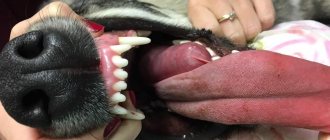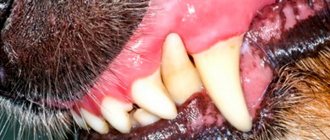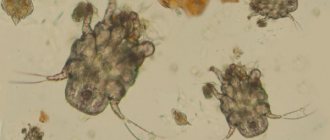Advice for dog owners - Prostate diseases in male dogs
Dear dog owners!
According to statistics, 60% of uncastrated males over 5 years old and 100% of uncastrated males older than 10-12 years have prostate hyperplasia. Timely castration of male dogs not used for reproduction prevents age-related prostate hypertrophy. Among the diseases of the prostate gland there are: - acute and chronic prostatitis - benign prostatic hyperplasia - squamous metaplasia of the prostate - prostate abscess - prostate cysts - neoplasia. The main clinical symptoms of prostate diseases: - urinary disorders: increased frequency of urination, urination in small portions, drops, urinary incontinence, blood in the urine (not only during urination, but also during periods of rest), recurrent urinary tract infections, urinary retention up to until complete obstruction; - systemic symptoms: chronic hyperthermia (increased body temperature), periods of acute fever, collapse, shock in the terminal stage of the disease; - motor dysfunction: deep pain and discomfort in the pelvic area, pain in the lower spine, weakness or paresis of the pelvic limbs, pain in long bones with metastases, septic arthritis, swelling of the pelvic limbs; - gastrointestinal symptoms (not always observed, but sometimes are the only symptoms): frequent urge to defecate (tenesmus), constipation, thin ribbon-like feces, one- or two-sided rectal diverticulum often forms with stagnation of feces and difficulties in defecation up to inability to empty the rectum; - sexual dysfunction: infertility, inability to mate or ejaculate. To diagnose prostate diseases, both laboratory (urinalysis, semen, blood tests) and visual methods (radiography, urography, ultrasound) are used. A clinical examination allows you to assess the size, pain, symmetry, homogeneity of the prostate and its position relative to surrounding tissues and organs, and the presence of associated symptoms. Treatment. Prostate hyperplasia in dogs over 5-7 years of age is considered normal if it is not accompanied by clinical symptoms. Castration is considered the most effective method for correcting the manifestations of prostate hyperplasia, after which prostatomegaly usually disappears within the first week. In addition, progestogens, antiandrogen drugs, 5-alpha reductase inhibitors, GnRH agonists or antagonists are prescribed. Covinan is convenient to use due to its prolonged action and relative safety. But in terms of effectiveness, conservative intervention is significantly inferior to surgical castration and is relevant mainly for stud dogs who need to preserve reproductive ability. The most controlled and noticeable effect with preservation of fertility is provided by 5-alpha reductase inhibitors (finasteride). Estrogens should be used very carefully, as they can provoke irreversible suppression of hematopoiesis and prostate metaplasia. For malignant changes in the prostate, neither surgical nor conservative intervention is effective. Treatment of prostatitis is most successful in the acute phase due to the permeability of the blood-prostatic barrier. The course of antibiotic therapy should be quite long (at least 4-6 weeks). If a dog has a persistent prostate infection, antibiotics must be used for the rest of his life to prevent the pathogen from entering the urinary tract. Among the antibiotics, fat-soluble drugs are preferable - fluoroquinolones (baytril, norbactin, enrofloxacin), trimethoprim sulfa, tetracycline, chloramphenicol. In difficult cases, an antibiotic is selected based on the sensitivity of the microflora. Chronic prostatitis is less treatable due to the activity of the blood-prostatic barrier, deterioration of blood supply and the development of tissue fibrosis. In some cases, prostate cysts and abscesses are treated primarily surgically by draining the cavities and castration. Prostaectomy (removal of the prostate gland in veterinary medicine is not justified due to the high risk. The main treatment is supplemented by symptomatic treatment - antispasmodics (baralgetas, spazgan) with an analgesic effect; in an acute condition with severe swelling of the prostate, a novocaine blockade with an antibiotic and a steroid subrectally above the base of the penis is advisable. With concomitant defecation disorders, measures are necessary to promote rectal emptying, possibly with surgical correction of rectal diverticulum.Acute bacterial prostatitis occurs with severe intoxication, up to sepsis and shock, and requires intensive detoxification therapy (drip infusions, antishock agents. Should be carefully monitored urine outflow, catheterization or cystocentesis is performed if necessary. In uncomplicated cases of prostatomegaly, homeopathic medicines for the correction of prostate hyperplasia (adenoma), herbal medicines (Tykveol, Peponen, Trianol, Prostamol Uno, Urtiron) may be useful. . For acute disorders of urination or defecation, you can use Vitaprost suppositories and drugs that reduce dysuric phenomena (dalfaz, omnic). Alpha-blockers are not always well tolerated; they are used when all other measures are ineffective and under the strict supervision of a doctor. Possible consequences of bacterial prostatitis include orchitis, epididymitis and infertility. Prostate cysts and neoplasms rarely lead to reproductive dysfunction. You can obtain detailed information on the issues of breeding dogs and cats and diseases of the reproductive system from the books of the Sofion publishing house “Guide to the reproduction and neonatology of dogs and cats” and “Endocrinology and reproduction of dogs and cats.”
Acute or chronic bacterial prostatitis
Another, much more serious disease of the male reproductive system is acute or chronic bacterial prostatitis. The causes of this serious disease in males include bacterial infection - the penetration of microorganisms into the prostate tissue. This penetration is carried out in various ways - ascending (through the genitourinary canal) and hematogenous (blood flow from another affected organ) pathways. The lymphogenous route (flow of lymphatic fluid) of spread of infection is extremely rare.
Normally, the urogenital canal of male dogs is sterile, but with the development of benign prostatic hyperplasia, with inflammation of the bladder due to hypothermia, with stagnation of urine due to blockage of the canal with a stone, the urine becomes infected, microorganisms from which easily penetrate into the spongy tissue of the prostate parenchyma and actively begin to multiply there. If the microbial infection is weak but repeated, then chronic bacterial prostatitis often develops. If the immune system is weak or microbial infection of the prostate is high, then acute bacterial prostatitis develops.
Symptoms of acute bacterial prostatitis in dogs: difficulty urinating, the appearance of blood in the urine, constipation, pain in the perineum, aggravated by defecation. Hyperemia (severe redness) of the skin of the perineum may indicate abscess formation (formation of a cavity with pus) of the prostate gland. To diagnose prostatitis in dogs, a blood test is performed, in which signs of an inflammatory reaction are noted, an ultrasound of the prostate gland is performed, noting an increase in the organ’s size, an increase in its echogenicity (this may indicate hardening of the prostate due to inflammation), and sometimes signs of an abscess are found.
Figure 4. Acute prostatitis in a male dog.
Treatment of prostatitis in male dogs is difficult because there is a barrier between the blood and the prostate tissue and the penetration of drugs into the prostate is slow. As antibacterial therapy, chloramphenicol is used 3 times a day, ciprofloxacin and norfloxacin 2 times a day or enrofloxacin 1 time a day for 4 to 6 weeks, depending on the severity of the process. Such long-term antibacterial treatment can harm the body and should be carried out under the supervision of a specialist and regular monitoring of tests. After relieving the symptoms of acute prostatitis in male dogs, it is recommended to perform castration. In cases of formation of a prostate abscess, it is necessary to drain it quickly in order to avoid rupture and the development of diffuse purulent peritonitis (inflammation of the entire abdominal cavity), which is deadly.
Figure 5. Prostate abscess in a male dog (marked with an arrow). On the left is the bladder.
Prostate inflammation and proper treatment in dogs
Prostatitis in dogs is a common pathology; it occurs, as is clear, in males. The disease is serious and leads to suffering for the animal and great stress and trouble for the dog owner. In the article we will look at the features of this pathology and find out what are the causes and symptoms of prostatitis in dogs. Let's find out how to treat prostatitis and what can be done to prevent the disease.
Description and reasons
Prostatitis is an inflammatory process in the prostate gland. The disease occurs in dogs over the age of five years. The pathology is serious, dangerous, and can lead to serious consequences: that is why the disease requires mandatory diagnosis and urgent treatment. The symptoms of the disease can be confused with cystitis, so in this case only a veterinarian should make a diagnosis and prescribe treatment.
The immediate cause of the disease in a dog is a bacterial infection that has penetrated the genitourinary organs. Sometimes the cause of the disease is some autoimmune pathology, which is very difficult to diagnose and treat.
Theoretically, a dog of any age can get prostatitis, but dogs that are 5-7 years old are more likely to get sick. This pathology can be caused by many reasons, but more often these are pathological inflammatory processes in the pelvic organs, as well as hormonal disorders. Let's look at the main reasons that cause this disease in dogs.
These are various hormonal disorders in the body, or illiterate treatment of the dog with hormonal drugs, or exceeding the dose of such drugs.
Diseases of internal organs: colitis, urethritis, proctitis negatively affect the condition of the prostate in dogs. Pathologies of an infectious nature can also be the cause of the disease. If the dog was misdiagnosed and treated for a long time with the wrong medications, this fact can also cause the disease.
Lack of hygiene procedures, the dog being in the dirt, among garbage, rubbish and in similar unsanitary conditions. Sometimes individual predisposition plays a role.
If a dog is inactive, it is more susceptible to prostatitis. Low immunity is also one of the main reasons.
The disease leads to an increase in the volume of the animal's prostate gland. This fact leads to a slowdown in blood circulation and the creation of favorable conditions for the proliferation of bacteria.
Causes of pathologies (adenoma and inflammation)
Prostatitis is an inflammation of the prostate gland, which can also lead to benign tissue growth (hyperplasia) or adenoma. In turn, as the gland grows, it can become infected, which will lead to inflammation.
If the prostate gland becomes inflamed, this leads to prostatitis.
Normally, the secretion of the gland has bactericidal properties, which suppress the onset of infection, but under the influence of various factors this function ceases to be performed and pathogenic microorganisms increase their virulence, causing inflammation of the organ.
Thus, talking about exclusively one pathology is not entirely correct, especially if the diagnosis has not been carried out in full.
Infections
Both infections and hormonal imbalances can lead to pathological processes, which occurs more often in older animals.
Infections are more common in older dogs.
In young male dogs, pathology can manifest itself as a consequence of impaired embryonic development.
Course of the disease and symptoms
Prostatitis in a male dog can be either acute or chronic. In the acute form, the disease manifests itself with the following symptoms:
- high temperature (up to +40 degrees);
- headache;
- nausea, vomiting;
- difficulty with bowel movements;
- loss of appetite;
- frequent urination with blood;
- difficulty urinating;
- severe pain;
- stiffness of the dog’s gait;
The animal may experience feverish conditions: permanent or temporary. The gait takes on “wooden” characteristics and the dog becomes inactive. Possibly indigestion in the form of constipation and diarrhea. A pet may lose a lot of weight during its illness. Sometimes the dog spends hours trying to perform the act of urination, but to no avail.
In addition to the above, a dog infected with this disease is likely to become infertile. That is, such a male cannot be used for breeding.
If you notice the listed symptoms in your dog, you need to take your pet to a veterinarian. The sooner the diagnosis is made and treatment begins, the more likely it will be to prevent possible complications of prostatitis. Note that although the acute form can be treated more quickly, it often leads to complications in the form of dangerous abscesses or even purulent peritonitis.
The chronic course of the disease does not have such pronounced symptoms. Most often, with a similar course of the disease, the dog periodically feels pain when urinating, but outwardly this fact does not manifest itself in any way and is invisible to the owner of the animal. In general, the dog’s condition is normal - the animal eats as usual, is quite active and cheerful. This lack of symptoms makes early detection of chronic prostatitis very difficult, which sometimes leads to serious consequences.
Chronic prostatitis in a dog can only be detected by examination by a veterinarian. Therefore, every pet owner should make it a habit to regularly examine their pet at the veterinary clinic, regardless of whether there are any alarming symptoms or not.
Diagnosis of prostatitis
When examining a dog, diagnosing prostatitis in some cases is quite difficult. Often this disease has symptoms similar to those of cystitis, urethritis, and tumor formations. The disease is diagnosed using the following methods:
- direct palpation of the prostate gland;
- study of biomaterials (potassium and urine);
- Ultrasound of the pelvis;
- examination of the prostate gland through the rectal opening;
The presence/absence of certain symptoms can also point the diagnosis in the right direction.
Since the symptoms of prostatitis are similar to those of many other diseases, additional examinations are sometimes required to make an accurate diagnosis. Prostatitis of the chronic type is especially difficult to diagnose; in this case, sometimes the dog even has to undergo a biopsy. Please note that the biopsy procedure is quite complex and dangerous, so it is performed only if there is no other way to correctly diagnose the dog’s condition.
In case of illness, it is important to diagnose this pathology in a timely manner. This way, treatment will be prescribed in a timely manner, which will save the reproductive and general health of the pet.
Diagnostics
If you detect at least one of the above signs, be sure to take your pet to the veterinarian. He will carefully question you about the dog’s entire health history, right up to the onset of the first symptoms of the disease. Initial routine laboratory tests will include a full range of blood tests , including a chemistry profile, as well as a complete urinalysis . The veterinarian will make a differential diagnosis, as there are many possible causes and conditions for this condition in a dog. This process involves carefully checking all obvious external symptoms to rule out each of the most common causes and helps to make a correct, extremely accurate diagnosis.
The doctor will carefully examine your dog and make some preliminary findings based on the physical examination. However, the preferred method for examining the prostate is ultrasound , since this method provides the most complete picture of the disease and provides maximum information about the size of the prostate gland and the development of tumors. If your veterinarian doesn't see something on the ultrasound, he or she may also order an x-ray . Semen samples will be taken for analysis, as well as a swab from the urinary tract. In some cases, your veterinarian may order a biopsy of the prostate tissue.
Necessary treatment of the prostate in a dog
It is important to begin treatment for prostatitis in dogs as early as possible. If you delay in starting therapy, the disease may progress into the chronic phase, when the symptoms will be less pronounced and the treatment itself will be more difficult. In the acute course of the disease, the dog, as a rule, feels very unwell, and its malaise is noticeable to the naked eye. Without proper care and treatment, the dog may even die.
Prostatitis is usually treated with antibiotics: the dog must take antibacterial drugs for three weeks. The drug is prescribed after examinations: the antibiotic drug must correspond to those pathogens that are directly “culpable” for the pathology of a particular dog. The most effective antibiotics for treating canine prostatitis are:
- clindamycin;
- trimethoprim;
- erythromycin;
- chloramphenicol.
In addition to the above, drugs from the group of quinolones and sulfonamides are also effective. If the case is severe and advanced, intravenous infusions of special nutrient solutions, as well as buffer (barrier) solutions, are used. These substances help eliminate or reduce the symptoms of intoxication.
In addition to antibiotics, non-steroidal anti-inflammatory drugs are used to quickly rid the dog of infection. However, long-term therapy with these drugs is prohibited, since they strongly damage the immune system. If there is a high temperature or pain, symptomatic treatment with appropriate antipyretic drugs and analgesics is prescribed.
Completion of treatment
When the course of treatment comes to an end, it will be necessary to take tests again to detect any remaining pathogens. If any are detected, the course of therapy will have to be extended. After the dog has fully recovered, a repeat control examination is scheduled six months after the end of treatment. If treatment with the prescribed drug does not produce results, the veterinarian prescribes another drug.
If, after two weeks of therapy, no significant improvement in the dog’s condition is noticed, and the level of leukocytes in the blood only increases, most often a decision is made to castrate the animal. This extreme measure allows you to avoid serious and sometimes fatal complications. Note that young dogs with prostatitis recover easier and faster than adult dogs. Young animals are rarely castrated; usually dogs over five years old undergo this operation.
If medical care was provided correctly and in a timely manner, then with acute prostatitis the dog recovers already on the 12th day of treatment. A mild form of the disease is treated at home, but a severe form is treated in a hospital.
Treating chronic prostatitis in dogs is more difficult than acute prostatitis. Sometimes it is even necessary to castrate the animal if the chronic course of the disease leads to complications. Chronic prostatitis leads to rupture of the prostate abscess; in this case, surgical intervention is required urgently. Even the most experienced surgeon cannot guarantee a positive treatment outcome.
If the case is not very severe, and the dog was sent for home treatment, you should see a veterinarian every week or two. This measure will help to adjust treatment in time. If prostatitis is chronic, then the dog should be under veterinary control for at least a month: this will help prevent relapses and complications of the disease.
Pay attention to the color of the dog's urine: the lighter the liquid becomes, the better the animal's condition becomes. When the urine becomes clear and light, as before the disease, we can talk about the animal’s complete recovery.
Home care and prevention
Every one to two weeks after starting treatment, it is imperative to show your pet to a veterinarian. At the same time, blood tests are taken again to assess the dynamics. In principle, it is better to take urine and samples of prostate secretions every three to five days, especially in complex cases: this way the specialist can understand whether the therapy is giving a positive result. You may need to treat your dog's prostate inflammation further.
Important! Constantly monitor how and “what” your dog urinates with - if the color of the urine gradually becomes lighter and the liquid itself becomes clearer, the pet is probably on the mend. Please note that when treating chronic prostatitis, the animal must be under the supervision of a veterinarian for at least a month, since in this case the risk of relapse is quite high. If anything worries you, or you think that clinical signs are reappearing, immediately notify your healthcare professional.
In addition, for about five weeks after the end of treatment, it is necessary to take samples of blood and prostate secretions in order to accurately determine whether the pathogen remains in the dog’s body, and whether the inflammatory process has “started” again.
Disease prevention
To prevent the dog from developing prostatitis, it is important to promptly treat all diseases of the genitourinary system that arise. Prostatitis often appears as a complication of an inflammatory process that was undertreated or ignored at the time.
You should regularly walk your dog outdoors - in any weather. Walking strengthens the dog, makes its immunity stronger, and activates the work of all internal organs.
Mate the male according to plan. Uncontrolled mating with different “partners” leads to the appearance of various infections of the genitourinary system. It is also important to maintain proper cleanliness of the animal’s genitals: wash the dog more often if it does not want to take care of its hygiene.
It is important to adjust the animal’s diet: the dog’s menu should include all the substances its body needs. If you cannot provide such nutrition yourself, it is better to use ready-made food, where all minerals and vitamins are taken into account.
If a male dog has a tendency to prostatitis, sometimes it is more profitable to castrate him. The same measure will ease the dog’s fate during regular matings. Have your dog checked by a veterinarian periodically. Early diagnosis will help cope with prostatitis faster and easier.
We learned why prostatitis is dangerous for a dog, and how this disease should be treated. Prostatitis can lead to quite serious complications, so treatment of the animal must begin immediately after diagnosis. Timely measures taken will allow you to get rid of the disease in a relatively short period of time and keep your pet healthy.
Prostate gland and its functions in the body
The main function of the prostate or prostate gland in the body is to produce a special secretion that helps transport and dilute the sperm released during ejaculation. This fluid also maintains the viability of sperm and promotes their movement outside the animal’s body.
In normal condition, the prostate in dogs weighing up to 10 kg has a size of up to 2 cm. With every 10 kg of weight, the size of the gland increases by 0.8-1 cm. The shape of the prostate is oval or round. This gonad is located near the neck of the bladder.
Benign prostatic hyperplasia
Benign prostatic hyperplasia is an increase in the size of the prostate in male dogs due to an increase in the organ cells themselves and their number, as well as the formation of small cysts in the parenchyma. This process is associated with an age-related decrease in the amount of testosterone and an increase in the level of estradiol in the blood in male dogs.
Symptoms of benign prostatic hyperplasia in male dogs rarely appear, more often in the later stages of the disease. Pet owners usually notice difficulty urinating and periodic constipation. When examined at a doctor's appointment, a rectal examination of the prostate is performed, during which the specialist notes the correct, symmetrical and painless increase in size of the organ. According to the results of a laboratory blood test, there are no signs of an inflammatory reaction; in a urine test, prostate cells without pronounced bacterial inflammation may be found. When conducting an ultrasound examination of the prostate in a male dog, the specialist notes a uniform enlargement of the organ without signs of cystic or tumor lesions. In some cases, for a more accurate diagnosis, a pneumocystogram is performed, which makes it possible to exclude concomitant pathology of the genitourinary system of male dogs.
An option for the treatment of benign prostatic hyperplasia in males with pronounced enlargement is castration. As a result of the removal of the gonads, atrophy of the prostate occurs, and the process of urination and defecation improves.
Differences between a malignant tumor and a benign one
The main difference between a malignant prostate tumor and a benign one is its rapid growth. Dogs are diagnosed with prostate adenocarcinoma. Such a tumor grows rapidly, metastases spread with lymph and affect the bladder, pelvic muscles, and colon.
With adenocarcinoma, the pet experiences pain when moving, which does not happen with adenoma. Other symptoms of oncology that distinguish it from a benign neoplasm include exhaustion of the animal, fever, depression and refusal to eat.
Causes of development of prostate adenoma in dogs
Veterinarians identify several reasons for the development of prostate adenoma in dogs:
- Hormonal disorders. The development of the disease is provoked by hormonal imbalance: the level of testosterone (male hormones) decreases, and estrogen (female hormones) increases.
- Heredity. There is a version that the predisposition to prostate adenoma is inherited.
Another possible reason for the development of pathology is the lack of regular mating. In this case, there is a risk of degeneration of a benign tumor into a malignant one.
Hyperplasia in dogs - what is the danger of the disease and what actions need to be taken
Hyperplasia in dogs is a rather insidious disease characterized by increased cell growth. They do not divide, but increase in size. Hyperplasia can reach truly enormous sizes.
Thus, increased growth of prostate cells in male dogs can lead to an enlargement of the gland to the size of a large orange. The animal suffers from painful sensations.
In addition, it has been proven that about 38-42% of all detected hyperplasias can degenerate into a malignant tumor.
There is also increased growth of physiological type cells. For example, increased growth of cellular structures in the gum area of puppies is a normal phenomenon associated with tooth growth. But at the same time, if hyperplasia of the oral mucosa in a dog develops as a complication of stomatitis, it can develop into a malignant course.
Symptoms and first signs of the disease
The tumor grows strongly and begins to compress the surrounding tissues, so the first signs and symptoms of the disease are the appearance of droplets of blood in the urine and difficulty urinating.
If the tumor becomes very large, the dog may experience discomfort and pain in the groin area. Because of this, the pet’s gait becomes awkward, the animal begins to drag its hind legs and limp.
Another sign of adenoma is frequent constipation. The tumor compresses not only the urethra, but also the rectum, making the passage of feces difficult. When emptying the intestines, the pet is worried, looks for a place for a long time, and may whine.
Symptoms and diagnosis of hyperplasia of various organs in dogs
The main signs and symptoms of hyperplasia do not appear immediately after the onset of the disease. They depend on the location of the source of pathology, the age of the animal and some other individual characteristics. Depending on the location, the signs will be as follows:
- Prostatic hyperplasia in dogs. Develops in uncastrated males. The main reason is changes in hormonal levels. Characteristic signs of the pathology are: problems with urination (polyuria, oliguria, diuresis, urinary incontinence). In advanced cases, prostate hyperplasia can provoke the appearance of blood in the excreted portion of urine. The animal first experiences discomfort and then pain. In some cases, an increase in body temperature and feverish conditions are recorded in a sick animal. Painful sensations in the spine lead to weakness of the pelvic limbs. The development of arthritis and edema in the pelvis is possible. Prostate hyperplasia in dogs can manifest itself as obstipation (constipation), changes in the characteristics of feces, and frequent urges to excrete feces. With difficulties with the toilet, rectal diverticula develop, unilateral or bilateral. Dogs with advanced benign prostate tumors are unable to mate normally and are also diagnosed with infertility. Diagnosis of the disease is carried out by taking laboratory tests of urine and blood, as well as using x-ray and ultrasound examinations.
- Gingival hyperplasia in dogs. One of the most characteristic signs is a change in the volume of the gum adjacent to the tooth. In advanced cases of pathology, altered gums can completely cover the surface of the tooth. The edges of the gums with hyperplasia are rounded. During the pathological process, false pockets are formed in which food debris accumulates. Bacterial microflora joins, which invariably leads to an inflammatory process - gingivitis or periodontitis. In addition to pain in the animal while eating, gum hyperplasia is characterized by darkening of the tooth enamel and the appearance of a repulsive odor from the mouth. Bleeding and hyperemia of the affected gum area is often observed. Possible increase in body temperature. The dog has difficulty chewing food and therefore often refuses to eat. To make a diagnosis, a biopsy of the affected tissue area is necessary. Microscopic examination reveals an increase in the volume of fibrous tissue, as well as inflammatory processes. When making a final diagnosis, not only laboratory data are taken into account, but also breed predisposition to the disease.
- Hyperplasia of the spleen in a dog. Nodular hyperplasia is a neoplastic type of regional proliferation of normal cellular structures of the parenchyma covering the spleen. This type of pathology is divided into lymphoid, fibrohistiocytic, hematopoietic, plasmacytic and mixed. With the development of splenic hyperplasia, characteristic signs are absent for a long time. With the development of the pathological process, the organ increases in volume, which is easily detected upon palpation. The pet may refuse food and appear depressed and depressed. To make a diagnosis, ultrasound diagnostics are used, which allows visualization of the affected area, changes in the shape of the spleen and its size. A veterinarian, when examining the abdominal organs using ultrasound diagnostics, also determines the possibility of metastases.
- Adrenal hyperplasia in dogs. A disease that is quite rare in dogs. Signs of pathology directly depend on the type of pathology. In the vast majority of clinical cases, adrenal hyperplasia is a congenital disease. Characteristic signs are poor development of the mammary glands, changes in the structure of the vessels of the fundus, pain in the head and cramps at night. Diagnosis includes laboratory blood tests (blood biochemistry), which can detect changes in the production of adrenocorticotropic hormone. Ultrasound diagnostics and radiographic examination are also performed.
- Endometritis. A dog has endometrial hyperplasia or endometritis, which occurs due to hormonal imbalance. Depending on the type of endometritis, closed or open, the symptoms will vary. The open form of endometritis is characterized by the appearance of discharge from the loop area, and the discharge smells unpleasant. The general body temperature rises, feverish states, refusal of food and general depression are observed. If a closed form of endometrial hyperplasia develops, purulent exudate accumulates inside the uterine cavity, causing an additional inflammatory process. The animal's condition is rapidly deteriorating, the size of the uterus is increasing in size. Against the background of purulent inflammation, kidney failure develops, the temperature rises, and ascites (fluid accumulation inside the abdominal cavity) may develop. Symptoms increase, the animal often drinks, refuses food, and vomits. Depressed state. Diagnosis includes an ultrasound examination, a general clinical blood examination and a biochemical panel. As a rule, ultrasound diagnostics is sufficient.
- Mammary gland hyperplasia in a dog. Fibroadenomatous hyperplasia is characterized by a sharp change in the size of one breast or several at once. Swelling occurs, and the connective tissue structures surrounding the mammary gland also increase in volume. Mammary hyperplasia is diagnosed mainly in dogs at a young age of up to 5 years. It is worth noting that mammary hyperplasia, unlike cancer in dogs, is quite rare. Swollen glands in dogs are painless, lumpy and soft. In advanced cases of pathology development, the risk of ulceration and further infection cannot be excluded. There is no secretion of milk in pathology. The veterinarian makes an accurate diagnosis based on the clinical picture and some studies. Differential diagnostics are carried out to identify mastitis or other oncological pathologies. A biopsy may be required.
- Sebaceous gland hyperplasia in dogs. A pathology that occurs frequently in dogs, but does not require special treatment. Symptoms of sebaceous gland hyperplasia are quite characteristic. At the base of the animal's tail, as a result of hypersecretion of the sebaceous gland, specific crusts and scales appear. The coat in this area always looks dirty, even despite frequent bathing. The skin at the site of the lesion undergoes hyperpigmentation. Complications during the development of a pathological condition of the sebaceous glands occur rarely and are associated with infection by pathogenic bacterial or fungal microflora.
Diagnostic methods
There are two methods for diagnosing this disease:
- Rectal palpation. The veterinarian inserts a finger into the anus and feels the tumor. The adenoma is painless, and the prostate gland itself is mobile and enlarged, hard to the touch.
- Ultrasound. Using this test, the veterinarian evaluates the shape, size and density of the tumor.
REFERENCE! X-ray can exclude other diseases of the prostate gland: abscess, prostatitis, cancerous tumors. Also, with the help of this study, the veterinarian evaluates the size of the lymph nodes.
Paraprostatic cysts
Another common disease of the prostate gland in male dogs is paraprostatic cysts - this is the process of formation of cystic structures outside the prostate gland. The reasons for the formation of such cysts in the prostate in male dogs are not clear, but they are often a consequence of acute prostatitis.
Symptoms of paraprostatic cysts in dogs. Reaching large sizes, cysts often compress neighboring organs, leading to impaired urination and defecation. Often they can be palpated (felt) through the abdominal wall. These formations are often confused with the bladder, and with a long process, calcium salts begin to be deposited in the wall of the cyst, leading to calcification. For diagnosis, an ultrasound scan of the prostate is performed, but it is necessary to catheterize the bladder to avoid misdiagnosis.
Figure 6. Paraprostatic cyst of a male dog (fibrin flakes are visible). Figure 7. Bladder of the same animal (arrow indicates urinary catheter).
Treatment of paraprostatic cysts in dogs is surgical. During the operation, it is necessary to completely remove the wall of the formation or, if this procedure is impossible, to perform marsupialization of the cyst - the process of opening the cyst, washing and suturing its edges to the skin of the abdominal wall. Over time, this cyst will completely atrophy and will not cause any problems to the dog.
Treatment regimen and drugs
The drug treatment regimen for adenoma includes the use of the following drugs:
- Antiandrogens or testosterone blockers. This group includes drugs such as Finasteride, Flutamide, Oxyflutamide. The first medicine is used for 2-3 months. Oxyflutamide and Flutamide reduce adenoma within 2-3 weeks.
- Progestins. These include the following substances: Medroxyprogesterone, Megastrol. Preparations containing these components effectively reduce the size of the affected prostate of the animal.
- Synthetic analogue of estrogen Diethylstilbestrol. This drug quickly reduces the size of the adenoma, but has many side effects. Long-term use of Diethylstilbestrol leads to stagnation of secretions, which causes infection to penetrate into the prostate parenchyma. Another side effect of the drug is suppression of hematopoietic function.
- Tamoxifen. A drug that stimulates the production of estrogen in the body of a male dog.
To alleviate the pet’s condition, use the following scheme:
- Gentos. The drug reduces the symptoms of the disease. Dosage for large dogs: 10 drops morning and evening. For small dogs, 4-7 drops are recommended. The drug is applied to the pet’s tongue for 2 weeks.
- Prostamol. This drug relieves inflammation and reduces the symptoms of adenoma. Medium and large dogs are given 1 pc. at 320 mg once a day or 2 pcs. At 160 mg twice a day. The course of treatment is 1 month.
- Phytolysin . This paste relieves inflammation and spasms in the prostate gland and has a diuretic effect. The drug is diluted in half a glass of water in a dosage of ¼-1 tsp, depending on the size of the pet. The resulting mixture is given to the dog 2-4 times a day.
The main disadvantage of drug treatment is the short-term effect. Under the influence of hormones, the adenoma decreases in size, but after a few months it grows again.
Surgical methods of treatment
The most effective method of treating prostate adenoma is surgical removal of the testicles of a male dog. After such an operation, the tumor disappears within a few weeks and the prostate returns to its previous size.
Before castration, your pet must be examined. To do this, the dog's blood is donated for biochemical and general analysis. The veterinarian will also prescribe an ECG and then an ultrasound of the heart, if necessary. These procedures will eliminate possible pathologies that could cause complications during anesthesia.











